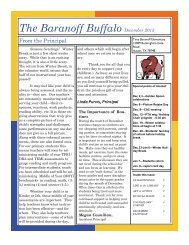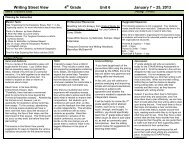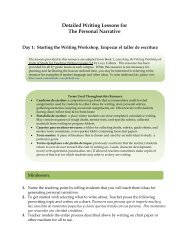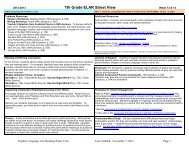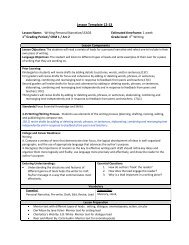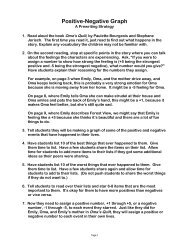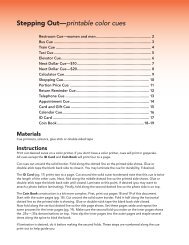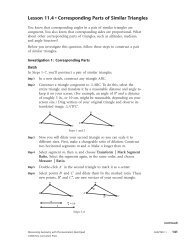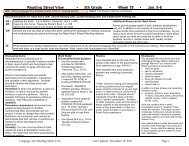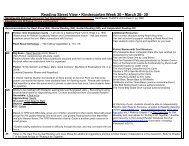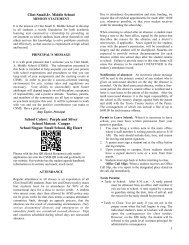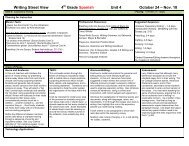You also want an ePaper? Increase the reach of your titles
YUMPU automatically turns print PDFs into web optimized ePapers that Google loves.
Materials:One graphing calculator andstraightedge per studentConnections to GeometryTEKS:(c ) Geometric patterns. Thestudent identifies, analyzes, anddescribes patterns that emergefrom two- and three-dimensionalgeometric figures.The student:(1) uses numeric and geometricpatterns to make generalizationsabout geometric properties,including properties of polygons,ratios in similar figures andsolids, and angle relationships inpolygons and circles;(2) uses properties oftransformations and theircompositions to makeconnections betweenmathematics and the real world inapplications such as tessellationsor fractals; and(3) identifies and applies patternsfrom right triangles to solveproblems, including special righttriangles (45-45-90 and 30-60-90)and triangles whose sides arePythagorean triples.(e.1) Congruence and thegeometry of size. The studentextends measurement conceptsto find area, perimeter, andvolume in problem situations.The student:(A) finds areas of regular polygonsand composite figures;(C) develops, extends, and usesthe Pythagorean Theorem.Teacher NotesNote: It may prove beneficial to create a geometrysoftware sketch of “<strong>Nesting</strong> <strong>Hexagons</strong>” once students haveperformed the calculations for Stages 1 and 2. Studentscan explore whether the size of the hexagon has any impacton the relationship between the stages. They can also usethe measurements to help determine a function rule for thissituation.It may also prove beneficial to model the organization ofdata in a table such as the one in the possible solutionstrategies. Encourage students to round area values to thenearest hundredth.Scaffolding Questions:If students have created a table, the following questions maybe asked:• Is there a common difference between the terms in thearea column of the table?• Is there a common second difference between the termsin the table?• Is there a common ratio between the terms in the table?• How is each stage related to the previous stage?Sample Solutions:1. The perimeter is 18. Use A = 1 ap to find the area of the2regular hexagon. Each interior angle of a regularhexagon is 120˚. The segments from each vertex to thecenter bisect the interior angles forming 6 equilateraltriangles. Therefore the radius and the sides of thehexagon have the same measure.Using 30-60-90 right triangle properties, the length of theapothem is found by dividing the hypotenuese, or in thiscase the radius, by 2 and multiplying by 3 . The lengthof the apothem for stage 0 is 3 3 , and the length of the2 ,radius is 3. The perimeter, p, is 6 times 3 units or 18units.H268Chapter 4: Area, Perimeter, and Volume
Texas Assessment ofKnowledge and Skills:Objective 1: The student willdescribe functional relationshipsin a variety of ways.Objective 2: The student willdemonstrate an understanding ofthe properties and attributes offunctions.Objective 6: The student willdemonstrate an understandingof geometric relationships andspatial reasoning.1A = ap21 ⎛ ⎞A =2⎜⎝3 3 182 ⎠⎟( )1A ≈ • • •2 3 18 32A = 27 3 or2A ≈ 23.38 square unitsObjective 8: The student willdemonstrate an understandingof the concepts and uses ofmeasurement and similarity.Connections to High SchoolGeometry: Supporting TEKSand TAKS:II. Transformations: FractalsIV. Planar Figures: Stained GlassCirclesThe apothem of the stage 0 hexagon is now the radius ofthe stage 1 hexagon. The length of the side of the stage1 hexagon is .3 32 .Using 30-60-90 right triangle properties, the length of theside is , and the length of the apothem is • .3 32 . 3 3232HChapter 4: Area, Perimeter, and Volume 269
1A = ap21 ⎛ ⎞A = ⎜ • ⎟ ⎛ ⎝ ⎠⎝ ⎜⎞2 3 3 318 32 2 2⎟⎠1A = • • • • •2 3 18 3 3 32 2 2A = 27 3 3• ≈ 17. 54 square units2 4A pattern emerges when the rest of the table is completed. In each new stage the sidelength, radius, apothem, and perimeter change by a factor ofprevious stage. The area in the new stage changes by a factor ofin the previous stage.32times the amount in the34times the amountH270Chapter 4: Area, Perimeter, and Volume
A recursive process of repeated multiplication can be used to generate the function rulefor the area.Another approach is to look for patterns in the area values themselves. It will facilitatethe development of a pattern if the values are rounded to the nearest hundredth. If thedifference between each term is found, no pattern emerges. If the difference betweeneach of those differences is found, no pattern emerges. However, if the ratios of the termsare found, a common ratio emerges. This means that each successive term can be foundby multiplying the previous term by this common ratio. This leads to the generation of theexponential rule for this situation.HChapter 4: Area, Perimeter, and Volume 271
A =27 32x⎛ 3⎞⎝ 4⎠2 27 3 310⎛ ⎞. A =≈ 1.322 ⎝ 4⎠3. Possible notation for the domain of the function might include one of the following:all real numbers −∞ < x < +∞ or - ∞,+ ∞ .( )The domain for the problem situation would be non-negative integers.4. Possible notation for the range of the function might include one of the following: realnumbers greater than 0 < y < +∞ or 0,+ ∞ .( )The range for the problem situation is more complicated. The range is the specific setof numbers corresponding to the domain values for the problem situation. For example,⎧27 3 81 3 243 3⎨2, 8, 32,... ⎫⎬.⎩⎭H272Chapter 4: Area, Perimeter, and Volume
Extension Questions:•stage( n)What is the relationship between the ratio of side lengthsstage( n − 1)and the ratio ofperimeters? How is this number related to the ratio of areas?The ratio of side lengths and the ratios of perimeters are bothis the ratio of the areas.32 .. This ratio squared• What is the largest possible area in this problem? Justify your answer.The largest possible area is or 23.38.The area of each successive stage istimes the area of the hexagon of the previousstage so the area is always smaller than the area of the hexagon of stage 0.• What is the smallest possible area in this problem? Justify your answer.There will never be a smallest area. Any area thought to be the smallest area can bemultiplied by3427 3234according to our rule in order to find a new stage with a smaller area.The area will approach 0 as the stage number gets very large but will never actually be 0.HChapter 4: Area, Perimeter, and Volume 273



